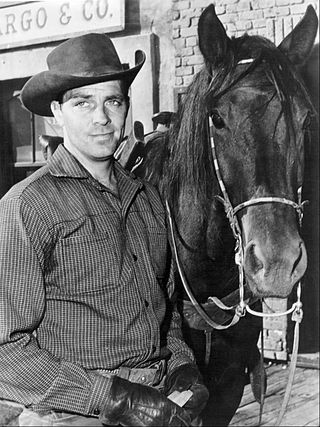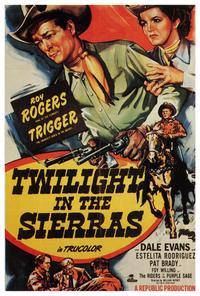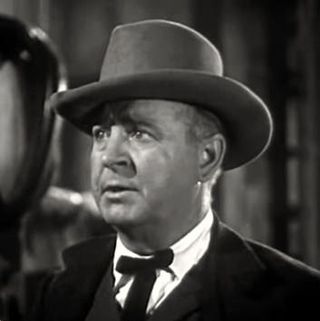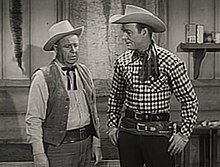
Roy Rogers, nicknamed the King of the Cowboys, was an American singer, actor, television host, and rodeo performer.
The Sons of the Pioneers are one of the United States' earliest Western singing groups. Known for their vocal performances, their musicianship, and their songwriting, they produced innovative recordings that have inspired many Western music performers and remained popular through the years. Since 1933, through many changes in membership, the Sons of the Pioneers have remained one of the longest-surviving country music vocal groups.

Dale Evans Rogers was an American actress, singer, and songwriter. She was the second wife of singing cowboy film star Roy Rogers.

Rex Elvie Allen Sr., known as "the Arizona Cowboy", was an American film and television actor, singer and songwriter; he was also the narrator of many Disney nature and Western productions. For his contributions to the film industry, Allen received a motion pictures star on the Hollywood Walk of Fame in 1975, located at 6821 Hollywood Boulevard.

Alfred "Lash" LaRue was a western motion picture star of the 1940s and 1950s.

Robert Ellsworth Patrick Aloysius Brady was an American actor and musician best known as the "comical sidekick" of the popular cowboy film and television star Roy Rogers on his eponymous radio and television series.

Dayle Lymoine Robertson was an American actor best known for his starring roles on television. He played the roving investigator Jim Hardie in the television series Tales of Wells Fargo and railroad owner Ben Calhoun in Iron Horse. He often was presented as a deceptively thoughtful but modest Western hero. From 1968 to 1970, Robertson was the fourth and final host of the anthology series Death Valley Days. Described by Time magazine in 1959 as "probably the best horseman on television", for most of his career, Robertson played in western films and television shows—well over 60 titles in all.

The Cowboy Channel is an American cable television network in over 42 million cable and satellite homes, which carries Western and rodeo sports. The network was founded in 1979 as the National Christian Network, and took the name FamilyNet in 1988 under the ownership of Jerry Falwell. It is owned by Patrick Gottsch, who also owns RFD-TV; Gottsch operates both channels under the brand Rural Media Group.
A movie ranch is a ranch that is at least partially dedicated for use as a set in the creation and production of motion pictures and television shows. These were developed in the United States in southern California, because of the climate.

Television Westerns are programs with settings in the later half of the 19th century in the American Old West, Western Canada and Mexico during the period from about 1860 to the end of the so-called "Indian Wars". More recent entries in the Western genre have used the neo-Western subgenre, placing events in the modern day, or the space Western subgenre but still draw inspiration from the outlaw attitudes prevalent in traditional Western productions.
Monte Hale was an American B-Western film star and country musician.

Fury is an American Western television series that aired on NBC from 1955 to 1960. It stars Peter Graves as Jim Newton, who operates the Broken Wheel Ranch in California; Bobby Diamond as Jim's adopted son, Joey Clark Newton, and William Fawcett as ranch hand Pete Wilkey. Roger Mobley co-starred in the two final seasons as Homer "Packy" Lambert, a friend of Joey's.
Frontier Doctor is an American Western television series starring Rex Allen that aired in syndication from September 26, 1958, until June 20, 1959. The series was also known as Unarmed and Man of the West.
Steve Donovan, Western Marshal is an American Western television series that aired in syndication from September 24, 1955 to June 6, 1956.

Twilight in the Sierras is a 1950 American Trucolor Western film directed by William Witney and starring Roy Rogers and his horse Trigger, along with Dale Evans, Estelita Rodriguez, and Pat Brady.

The Lone Ranger is an American Western television series that aired on the ABC Television network from 1949 to 1957, with Clayton Moore in the starring role. Jay Silverheels, a member of the Mohawk Aboriginal people in Canada, played the Lone Ranger's Indian companion Tonto.

Harry William Harvey Sr. was an American actor of theatre, film, and television. He was the father of actor, script supervisor, and director Harry William Harvey Jr. He is best known for his performances on The Roy Rogers Show (1951-1957), and The Lone Ranger (1949).
The Roy Rogers Show was a 30-minute Western radio program in the United States. It began in 1944, ended in 1955, and was carried on more than 500 stations. Because of demands on Rogers' time for personal appearances and making films, the show was one of the first radio series to be transcribed.

Stories of the Century is a 39-episode Western historical fiction television series starring Jim Davis that ran in syndication through Republic Pictures between 1954 and 1955.
The Roy Rogers and Dale Evans Show was a musical variety series that aired Saturday evenings from 7:30 to 8:30 p.m. on ABC from September 29, 1962 until December 22, 1962.













